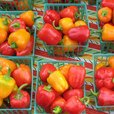Do you ever wonder where the time goes? I never seem to have enough hours in the day to do everything I want to.
Yesterday, I was off work. I thought the day was going to be rainy and nasty out, but instead the sun came out and it was the perfect day for me to get some more yard work done.
I have a very large vegetable garden, plus a fair-sized herb garden. I start a lot of my herbs early in a starter tray for transplants. Then I buy my tomato and pepper plants from the Cole County Masters Gardeners Plant Sale. Why don’t I grow my own tomato and pepper plants….simple: I am a Master Gardner and I spend about 35 hours between Feb-April in our greenhouse in Jeff City starting seeds, transplanting and caring for plants in our greenhouse, so I really do grow tomato and pepper plants.
Today, I separated out my purple basil, lemon basil and then changed out the dirt in all my containers. Plus, I had my husband pick-up mulch on his way home to mulch all the landscape around the house, which we did when he got home.
I also had to lay plastic all over my herb garden and mulch it as well. (Yes, I’m getting lazy…the plastic will now make it so I don’t have to worry about weeding it.)
Somewhere in the middle of all of this I whipped up an old stand-by recipe for dinner tonight:
Shrimp Scampi & Lemon Spaghetti
by Lane
Salt
1 pound spaghetti
4 T. butter
4 cloves garlic, finely chopped or just use garlic powder
1/2 teaspoon crushed red pepper flakes
2 lemons, juiced and zested or 4 T. lemon juice
3/4 cup heavy cream
1 cup grated Parmigianino Reggiano
Parsley and basil flakes, ½ tsp of each
Bring your pasta to a boil and be sure to salt it. Cook according to directions.
In another pot melt butter, garlic and red pepper flakes. After the pasta has boil for about 8 minutes add a cup of the water from the pasta water to the butter mixture. Add cream and lemon juice and season with all seasonings (to suit your own taste). Remove from heat and add cheese and toss mixture with the drained pasta. Let the pasta and sauce sit, tossing occasionally.
While sauce is setting….cook your shrimp.
Shrimp Scampi
1 pound raw shrimp, shells and tails removed
1 T. parsley
1 tsp. salt
1 tsp. garlic powder
3 T. butter
1 red bell pepper, thinly sliced
1 yellow bell pepper, thinly sliced
Heat large skillet and belt the butter. Add shrimp, peppers and season with seasonings. Cook and toss shrimp around to coat with butter. Cook until shrimp are pink. DO NOT OVERCOOK SHRIMP.
Remove and drain excess butter from shrimp.Give pasta one more last toss and plate some and top it with some shrimp.Serve with crusty French bread and salad. Makes great leftovers! and salad. Makes great leftovers!
April 23, 2008
Shrimp Tonight
Posted by
Lane
at
4/23/2008
1 comments
![]()
Labels: Gardening, Healthy Meals, Seafood, Vegetables
April 22, 2008
Portobello Chicken and Chives
Visiting the farmers’ markets is one of my favorite ways to get the very best local produce around, plus that opportunity to visit with the producer about their operation and family farm is a great learning experience.
I shopped at the Columbia Farmers’ Market last weekend and picked-up a few items to make a great meal the other night. This Portobello Chicken and Chives recipe is perfect for a Saturday night in with my husband. Fresh garlic, mushrooms and chives from my herb garden made this bursting with flavor.
This recipe comes from the Kansas City Farmers’ Market cookbook, “In-Season, Cooking Fresh from the Kansas City Farmers’ Market.” This is a great cookbook and makes a great addition to your cookbook collection.
Portobello Chicken and Chives
From the In-Season, Cooking Fresh From the Kansas City Farmers’ Market
4 boneless chicken breasts
1 cup dry white wine
1/3 cup extra virgin olive oil
4 cloves of garlic
1 tsp. kosher salt
½ tsp. cracked pepper
6 oz. baby Portobello mushrooms
1 small bunch of chives
½ cup chicken stock
½ cup cream
Pound chicken breast to about ½ inch thick and marinate in the wine for at least 4 hours ( do it overnight).
In a large skillet heat olive oil. Mince garlic and add to the oil along with the salt and pepper. Remove the chicken from marinade. Saute chicken in the oil for about 5 minutes on each side.
Slice mushrooms thinly and add to the skillet. Cut chives thinly and add chives and stock to the skillet. Cover and simmer for 10-15 minutes or until the chicken is done.
Add cream and cook uncovered for another 5 minutes to thicken the sauce.
Serves 4. Suggested wine: Pinot Noir
Posted by
Lane
at
4/22/2008
3
comments
![]()
Labels: Chicken, Farmers' Markets, Gardening, Healthy Meals
April 16, 2008
Seven Reasons to Eat Local Food
 It’s mid-April and markets around Missouri are opening up shop for the beginning of farmers’ market season. Although some markets have been open since about the third week of March, many of the more than 135 Missouri markets are opening within the next two weeks.
It’s mid-April and markets around Missouri are opening up shop for the beginning of farmers’ market season. Although some markets have been open since about the third week of March, many of the more than 135 Missouri markets are opening within the next two weeks.
Posted by
Lane
at
4/16/2008
0
comments
![]()
Labels: Farmers' Markets, Healthy Meals, Local Missouri Food
April 15, 2008
Parking Lot Cookies
 My gal pal Danni passed along this recipe to me about a week and half ago. When I first read the ingredients I didn’t know how these cookies would turn out (with oatmeal and rice crispies). Plus, when I started to mix the cookies up how thick they became the more ingredients I added.
My gal pal Danni passed along this recipe to me about a week and half ago. When I first read the ingredients I didn’t know how these cookies would turn out (with oatmeal and rice crispies). Plus, when I started to mix the cookies up how thick they became the more ingredients I added.
But, these are very tasty and easy to prepare….would be perfect for a football tailgate!
Thanks Danni for sharing.
Preheat oven to 350 degrees.
Posted by
Lane
at
4/15/2008
3
comments
![]()
Labels: Baked Goods, Cakes and Cookies








